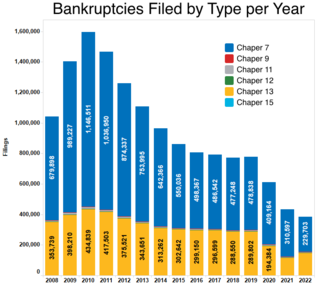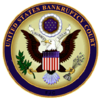Bankruptcy is a legal process through which people or other entities who cannot repay debts to creditors may seek relief from some or all of their debts. In most jurisdictions, bankruptcy is imposed by a court order, often initiated by the debtor.
Chapter 11 of the United States Bankruptcy Code permits reorganization under the bankruptcy laws of the United States. Such reorganization, known as Chapter 11 bankruptcy, is available to every business, whether organized as a corporation, partnership or sole proprietorship, and to individuals, although it is most prominently used by corporate entities. In contrast, Chapter 7 governs the process of a liquidation bankruptcy, though liquidation may also occur under Chapter 11; while Chapter 13 provides a reorganization process for the majority of private individuals.
Chapter 7 of Title 11 U.S. Code is the bankruptcy code that governs the process of liquidation under the bankruptcy laws of the U.S. In contrast to bankruptcy under Chapter 11 and Chapter 13, which govern the process of reorganization of a debtor, Chapter 7 bankruptcy is the most common form of bankruptcy in the U.S.
Title 11 of the United States Code sets forth the statutes governing the various types of relief for bankruptcy in the United States. Chapter 13 of the United States Bankruptcy Code provides an individual with the opportunity to propose a plan of reorganization to reorganize their financial affairs while under the bankruptcy court's protection. The purpose of chapter 13 is to enable an individual with a regular source of income to propose a chapter 13 plan that provides for their various classes of creditors. Under chapter 13, the Bankruptcy Court has the power to approve a chapter 13 plan without the approval of creditors as long as it meets the statutory requirements under chapter 13. Chapter 13 plans are usually three to five years in length and may not exceed five years. Chapter 13 is in contrast to the purpose of Chapter 7, which does not provide for a plan of reorganization, but provides for the discharge of certain debt and the liquidation of non-exempt property. A Chapter 13 plan may be looked at as a form of debt consolidation, but a Chapter 13 allows a person to achieve much more than simply consolidating his or her unsecured debt such as credit cards and personal loans. A chapter 13 plan may provide for the four general categories of debt: priority claims, secured claims, priority unsecured claims, and general unsecured claims. Chapter 13 plans are often used to cure arrearages on a mortgage, avoid "underwater" junior mortgages or other liens, pay back taxes over time, or partially repay general unsecured debt. In recent years, some bankruptcy courts have allowed Chapter 13 to be used as a platform to expedite a mortgage modification application.
Personal bankruptcy law allows, in certain jurisdictions, an individual to be declared bankrupt. Virtually every country with a modern legal system features some form of debt relief for individuals. Personal bankruptcy is distinguished from corporate bankruptcy.
Debt restructuring is a process that allows a private or public company or a sovereign entity facing cash flow problems and financial distress to reduce and renegotiate its delinquent debts to improve or restore liquidity so that it can continue its operations.

In the United States, bankruptcy is largely governed by federal law, commonly referred to as the "Bankruptcy Code" ("Code"). The United States Constitution authorizes Congress to enact "uniform Laws on the subject of Bankruptcies throughout the United States". Congress has exercised this authority several times since 1801, including through adoption of the Bankruptcy Reform Act of 1978, as amended, codified in Title 11 of the United States Code and the Bankruptcy Abuse Prevention and Consumer Protection Act of 2005 (BAPCPA).

The Bankruptcy Abuse Prevention and Consumer Protection Act of 2005 (BAPCPA) is a legislative act that made several significant changes to the United States Bankruptcy Code.
Chapter 12 of Title 11 of the United States Code, or simply chapter 12, is a chapter of the Bankruptcy Code. It is similar to Chapter 13 in structure, but it offers additional benefits to farmers and fishermen in certain circumstances, beyond those available to ordinary wage earners. Chapter 12 is applicable only to family farmers and fishermen.
A fraudulent conveyance or fraudulent transfer is the transfer of property to another party to prevent, hinder, or delay the collection of a debt owed by or incumbent on the party making the transfer, sometimes by deliberately rendering the transferring party insolvent. It is generally treated as a civil cause of action that arises in debtor/creditor relations, typically brought by creditors or by bankruptcy trustees against insolvent debtors, but in some jurisdictions there is potential for criminal prosecution.
Consumer bankruptcy in Canada is governed by the Bankruptcy and Insolvency Act ("BIA"). The legislation is complemented by regulations, as well as directives from the Office of the Superintendent of Bankruptcy that provide guidelines to trustees in bankruptcy on various aspects of the BIA.

The Bankruptcy and Insolvency Act is one of the statutes that regulates the law on bankruptcy and insolvency in Canada. It governs bankruptcies, consumer and commercial proposals, and receiverships in Canada.
Bankruptcy is a legally declared inability or impairment of ability of an individual or organization to pay their creditors. In most cases personal bankruptcy is initiated by the bankrupt individual. Bankruptcy is a legal process that discharges most debts, but has the disadvantage of making it more difficult for an individual to borrow in the future. To avoid the negative impacts of personal bankruptcy, individuals in debt have a number of bankruptcy alternatives.
An unfair preference is a legal term arising in bankruptcy law where a person or company transfers assets or pays a debt to a creditor shortly before going into bankruptcy, that payment or transfer can be set aside on the application of the liquidator or trustee in bankruptcy as an unfair preference or simply a preference.
In United States bankruptcy law, an automatic stay is an automatic injunction that halts actions by creditors, with certain exceptions, to collect debts from a debtor who has declared bankruptcy. Under section 362 of the United States Bankruptcy Code, the stay begins at the moment the bankruptcy petition is filed. Secured creditors may, however, petition the bankruptcy court for relief from the automatic stay upon a showing of cause.
Toibb v. Radloff, 501 U.S. 157 (1991), was a case in which the United States Supreme Court held that individuals are eligible to file for relief under the reorganization provisions of chapter 11 of the United States Bankruptcy Code, even if they are not engaged in a business. The case overturned the lower courts ruling which restricted individuals to chapter 7.
A cram down or cramdown is the involuntary imposition by a court of a reorganization plan over the objection of some classes of creditors.
The history of bankruptcy law in the United States refers primarily to a series of acts of Congress regarding the nature of bankruptcy. As the legal regime for bankruptcy in the United States developed, it moved from a system which viewed bankruptcy as a quasi-criminal act, to one focused on solving and repaying debts for people and businesses suffering heavy losses.
Bankruptcy in Irish Law is a legal process, supervised by the High Court whereby the assets of a personal debtor are realised and distributed amongst his or her creditors in cases where the debtor is unable or unwilling to pay his debts.
Bankruptcy in Florida is made under title 11 of the United States Code, which is referred to as the Bankruptcy Code. Although bankruptcy is a federal procedure, in certain regards, it looks to state law, such as to exemptions and to define property rights. The Bankruptcy Code provides that each state has the choice whether to "opt in" and use the federal exemptions or to "opt out" and to apply the state law exemptions. Florida is an "opt out" state in regard to exemptions. Bankruptcy in the United States is provided for under federal law as provided in the United States Constitution. Under the federal constitution, there are no state bankruptcy courts. The bankruptcy laws are primarily contained in 11 U.S.C. 101, et seq. The Bankruptcy Code underwent a substantial amendment in 2005 with the "Bankruptcy Abuse Prevention and Consumer Protection Act of 2005", often referred to as "BAPCPA". The Bankruptcy Code provides for a set of federal bankruptcy exemptions, but each states is allowed is choose whether it will "opt in" or "opt out" of the federal exemptions. In the event that a state opts out of the federal exemptions, the exemptions are provided for the particular exemption laws of the state with the application with certain federal exemptions.



